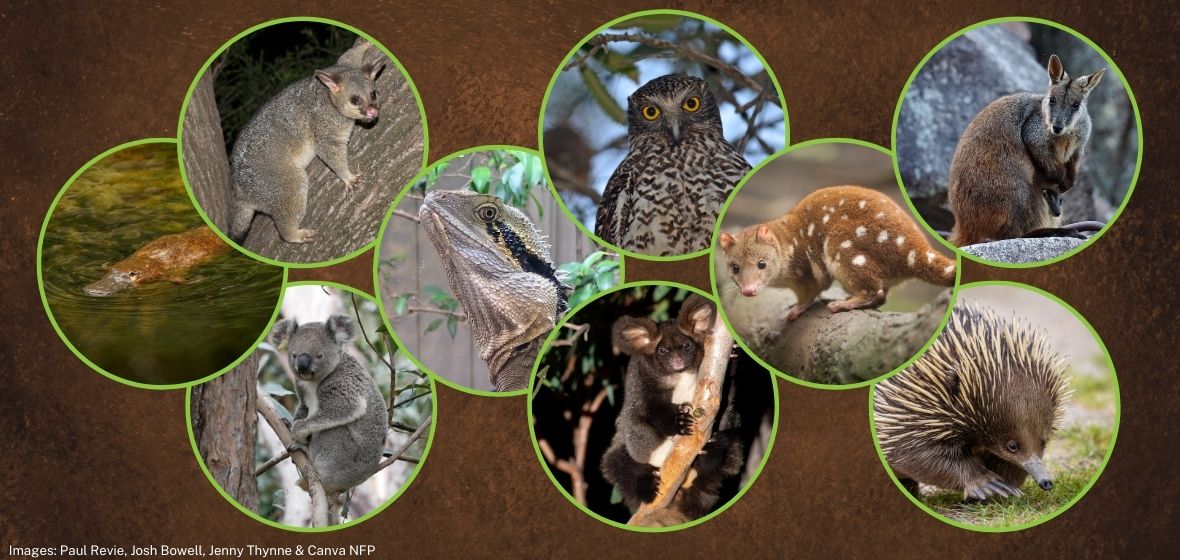27 February 2024 | By Wenda Shurety
Whether you’re in your backyard, exploring a park, or hiking through the bush, do you ever wonder what wildlife species are nearby? Even when wildlife isn’t readily visible, they often leave subtle traces of their presence. One such clue that nature leaves behind is scat, the faeces of animals.
Connecting people with wildlife
This World Wildlife Day, on 3 March 2024, Wildlife Queensland is celebrating one of our key passions: connecting people with their local wildlife.
In this spirit, we’ll delve into the fascinating world of scatology (the scientific study of faeces) to help discover who’s been roaming around our surroundings. You don’t need to spot the animals themselves to know they’re nearby.
Scatology provides clues
Scat isn’t just random waste; it’s a treasure trove of insights. Here’s why:
- Species Identification: Different animals produce distinct scat. By examining its size, shape, and contents, we can pinpoint the species responsible.
- Dietary Clues: Scat reveals an animal’s diet. Herbivores leave fibrous, plant-filled droppings, while carnivores produce more compact, protein-rich scat.
- Territorial Markers: Just like leaving a business card, animals use scat to mark their territory. Brush-tailed rock wallabies and brushtail possums are notorious for this, where their scat acts as a “keep out” sign.
Become a scat detective
Learn how to identify some Queensland wildlife species from their scat:
Brush-tailed rock-wallaby (Petrogale penicillate)

© Wildlife Queensland
In rocky areas, these agile climbers leave light brown to dark brown pellets, often with a twist.
Brushtail possum (Trichosurus vulpecula)

© Maaike Hofman
Possums are tree-dwellers, so their dark, cylindrical scat may be found high up in trees, rooftops, or fences
Greater glider (Petauroides Volans)

© Maaike Hofman
These nocturnal gliding marsupials leave small, elongated pellets in their territorial areas. Look for their scat in eucalyptus forests, primarily where they feed on leaves.
Koala (Phascolarctos cinereus)

© Jessica Lovegrove-Walsh
Their scat resembles oval or torpedo-shaped pellets, contains undigested plant matter and smells like eucalyptus. The colour is mainly red-brown to brown but can be blue-green, grey-green or yellow-brown. Keep an eye out for these around the base of gum trees, their favourite snack spots.
Platypus (Ornithorhynchus anatinus)

© Tamielle Brunt
These unique mammals leave behind distinctive soft, cylindrical droppings often found near waterways where they forage for food.
Powerful owl (Ninox strenua)

© Dr Nick & Lucy Parker Paul
The scat from these magnificent birds resembles a large splash of white paint and is often discovered near riparian vegetation.
Short-beaked echidna (Tachyglossus aculeatus)

© Chris Burton
Their long, cylindrical scat can be found in various habitats, from forests to grasslands. Sometimes, they leave behind a pile of ants and insect exoskeletons.
Spotted-tail quoll (Dasyurus maculatus)

© Logan City Council
Like foxes, their scat is similar in appearance to that of a small dog, often containing hair, bones, and fruit seeds. DNA or hair analysis is used for precise identification.
Water dragon (Intellagama lesueurii)

© Wildlife Queensland
These semi-aquatic lizards are commonly found near water bodies like ponds, creeks and swimming pools. Depending on their diet, their scat is elongated and may contain bits of prey or plant material.
Scat identification helps Wildlife Queensland
During fieldwork, Wildlife Queensland project officers frequently search for signs of animal scat. Scat identification helps them determine what kind of animal they’re tracking, its dietary habits, potential health issues, and preferred habitats. Additionally, the discovery of scat, whether from the target species or its predators, aids in selecting the best locations for camera traps for wildlife monitoring.
Wildlife Queensland Projects Manager Matt Cecil explains, “Scat identification plays a crucial role in detecting endangered species in regions where they were once thought to be extinct. Even a minor discovery can have significant implications for the conservation of specific animals, such as spotted-tail quolls.”
Identifying wildlife from scat not only provides insights into the animals’ presence but also helps us understand their diet, behaviour, and habitat preferences.
Next time you’re out and about, take a moment to observe the natural world around you — it’s incredible what you may find, even when the animals remain hidden from view.
What you can do
- Take a photo and let us know if you find brush-tailed rock-wallaby, spotted-tailed quoll, platypus or greater glider scat.
- Report your sightings if you see a brush-tailed rock-wallaby, spotted-tailed quoll, platypus, yellow-bellied glider, greater glider or short-beaked echidna.
- For more information on our species of interest and how you can help, please visit Brush-tailed Rock-wallaby Conservation Network, Quoll Seekers Network, PlatypusWatch, EchidnaWatch, and Queensland Glider Network.
- Subscribe to Talking Wildlife to learn more about your local wildlife plus Wildlife Queensland’s latest news and offers.

